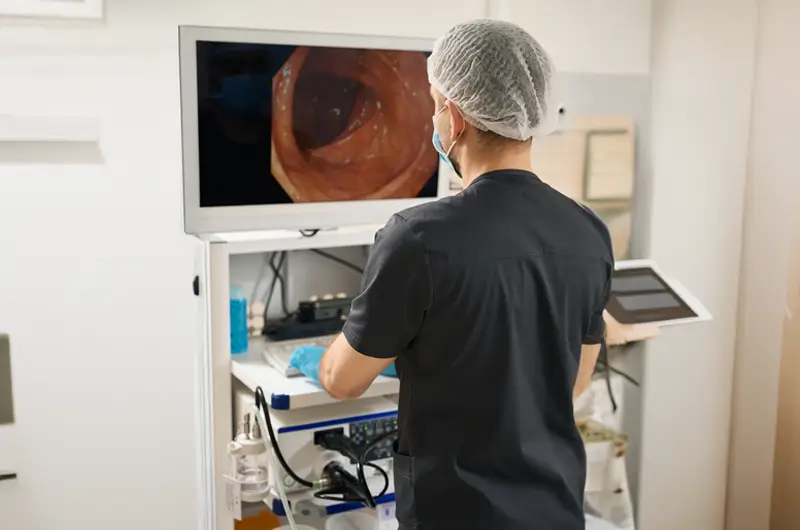According to the Centers for Disease Control and Prevention (CDC), in 2020, 126,240 new colorectal cancers were reported in the U.S., with 51,869 deaths from colorectal cancer. Colonoscopy is the most common procedure used for CRC screening. Recent policy changes and measures to prevent surprise billing have expanded the reach of free colorectal cancer (CRC) screenings, making them accessible to a larger population. However, it is crucial for physicians to submit the appropriate procedure and diagnosis codes in order to avoid denials for colonoscopy claims. In this regard, the assistance of a professional gastroenterology medical coding company can be invaluable. Experts can ensure accurate and efficient gastroenterology coding, ensuring that physicians maximize the benefits of the policy changes while minimizing errors and potential issues.


Maximize your reimbursement potential with our gastroenterology medical billing and coding services.
Colonoscopy Coding Guidelines – Key Points
Colonoscopy is the preferred screening method for patients with hereditary CRC syndromes or those with long-standing inflammatory bowel disease with colon involvement. Experts recommend colonoscopy every 10 years for people at average risk as long as their test results are negative (American Cancer Society). Colonoscopy serves as the definitive test when other screening tests yield positive results. It is the most sensitive screening method and unique in its ability to both remove precancerous lesions through resection and obtain biopsies of neoplastic lesions.
Colonoscopies can be either preventive (screening) or diagnostic. A screening colonoscopy is a test provided in the absence of signs or symptoms. It is performed on an asymptomatic person for the purpose of testing for the presence of colorectal cancer or colorectal polyps. Diagnostic colonoscopy is performed when there is an abnormal finding, sign or symptom (such as abdominal pain, bleeding, diarrhea, etc.).
Knowing the billing differences between screening and therapeutic colonoscopies ensures correct use of diagnosis codes and modifiers which is critical to ensure proper reimbursement and to avoid patient billing surprises.
Coverage for Colonoscopy
- Medicare covers colonoscopy:
- Once every 2 years for those at high risk (regardless of age)
- Once every 10 years for those who are at average risk
- Four years after a flexible sigmoidoscopy for those who are at average risk
- When colonoscopy is done for screening, the test is covered at no cost at any age (no co-insurance, co-payment, or Part B deductible). However, if the procedure includes a biopsy or removal of a growth, it is no longer a “screening” test, and the patient will be charged the co-insurance and/or a co-pay (though they do not have to pay the deductible).
- The co-insurance requirement for planned colorectal screening services, which transition into diagnostic or therapeutic procedures, will gradually be reduced to 0% between 2023 and 2030. In 2022, the co-insurance amount stood at 20%, and it has been lowered to 15% for the period between 2023 and 2026. Starting from 2030, no co-insurance will be applicable. (aapc.com).
2023 Updates
The Centers for Medicare and Medicaid Services (CMS) has made positive changes that will benefit patients in the 2023 Physician Fee Schedule rule released on November 1, 2022:
- The age for colorectal cancer (CRC) screening has been lowered from 50 to 45. This means that individuals can now start screening for CRC at the age of 45, without incurring any copay or deductible charges.
- Prior to 2022, colonoscopy was categorized as a diagnostic test, requiring patients to pay deductibles and co-insurance amounts. Starting January 1, 2023, for Medicare beneficiaries who undergo a non-invasive screening test and receive a positive result, the follow-up test will be treated as a screening test rather than a diagnostic one, excluding any additional patient financial obligations.
Coding Colonoscopy for CRC screening
- Screening Colonoscopy (No Polyps Removed)
Procedure codes
For commercial and Medicaid patients, use the following CPT codes:
45378 (Colonoscopy, flexible, proximal to splenic flexure; diagnostic, with or without collection of specimen(s) by brushing or washing, with or without colon decompression [separate procedure])
In Medicare patients, HCPCS codes are used to differentiate between screening and diagnostic colonoscopies. For Medicare patients, use:
| G0121 | Colorectal cancer screening; colonoscopy on individual not meeting criteria for high risk |
| G0105 | Colorectal cancer screening; colonoscopy on individual at high risk |
ICD-10-CM codes
| Z12.11 | Encounter for screening for malignant neoplasm of colon (Note: this code must be listed first when reporting multiple diagnosis codes) |
| Z12.12 | Encounter for screening for malignant neoplasm of rectum (Note: this code must be listed first when reporting multiple diagnosis codes) |
| Z80.0 | Family history of malignant neoplasm of digestive organs |
| Z83.71 | Family history of colonic polyps |
| Z85.038 | Personal history of other malignant neoplasm of large intestine |
| Z85.048 | Personal history of other malignant lesion of rectum, rectosigmoid junction and anus |
| Z86.010 | Personal history of colonic polyps |
- Screening Colonoscopy With Polyp Removal
If polyps are removed, the appropriate CPT code should be used based on the removal technique.
Procedure Codes
For commercial insurance and Medicare, use
| 45379 | Colonoscopy with removal of foreign body (s) |
| 45380 | Colonoscopy, flexible; with biopsy, single or multiple |
| 45384 | Colonoscopy, flexible; with removal of tumor(s), polyp(s), or other lesion(s) by hot biopsy forceps |
| 45385 | Colonoscopy, flexible; with removal of tumor(s), polyp(s), or other lesion(s) by snare technique |
| 45388 | Colonoscopy, flexible; with ablation of tumor(s), polyp(s), or other lesion(s) (includes pre- and post-dilation and guide wire passage, when performed) |
Modifier 33: To ensure that the colonoscopy is recognized as a screening service, add Modifier 33 (preventive services) to each CPT code submitted on the claim.
Here’s an example from the American Gastroenterological Association: If a physician performing a screening colonoscopy on a patient with commercial insurance finds and removes a polyp with a snare, use CPT code 45385 and append modifier 33 to the CPT code.
ICD-10-CM Codes
| Z12.11 | Encounter for screening for malignant neoplasm of the colon (Note: this code must be listed first when reporting multiple diagnosis codes) |
| Z12.12 | Encounter for screening for malignant neoplasm of rectum (Note: this code must be listed first when reporting multiple diagnosis codes) |
| D12.0 | Benign neoplasm of the cecum |
| D12.4 | Benign neoplasm of the descending colon |
| D12.8 | Benign neoplasm of the rectum |
- Reporting a screening colonoscopy that became therapeutic or diagnostic for Medicare patients
One or more polyps may be removed at the time of a screening colonoscopy. Since the procedure was initiated as a screening, the screening diagnosis is primary and the polyp(s) is secondary. The appropriate code (CPT code 45379—45392) should be reported for the diagnostic or therapeutic procedure performed. Append modifier (Colorectal cancer screening test, converted to diagnostic test or other procedure) to the CPT code.
- Reporting an incomplete colonoscopy for Medicare patients
According to Medicare, “A covered colonoscopy that is attempted but cannot be completed because of extenuating circumstances is considered to be an incomplete colonoscopy (the inability to advance the colonoscope to the cecum or to the colon-small intestine anastomosis due to unforeseen circumstances)”. The failed procedure is billed and paid using the following procedure codes:
| 45378 | Colonoscopy, flexible; diagnostic, including collection of specimen(s) by brushing or washing, when performed (separate procedure) |
| 44388 | Colonoscopy through stoma; diagnostic, including collection of specimen(s) by brushing or washing, when performed (separate procedure) |
| G0105 | Colorectal cancer screening; colonoscopy on individual at high risk |
| G0121 | Colorectal cancer screening; colonoscopy on individual not meeting criteria for high risk |
Modifier -53 (discontinued procedure) must be appended to any procedure code submitted when billing for a failed colonoscopy attempt.
In an LCD Reference article, Medicare further clarifies: “When a covered colonoscopy is next attempted and completed, Medicare will pay for that colonoscopy according to its payment methodology for this procedure, as long as all coverage conditions are met. This applies to both screening and diagnostic colonoscopies”.
Documentation Guidelines
Physicians must ensure thorough documentation of the condition and treatment provided. Medical records must be readily available for submission to Medicare upon request, particularly in cases where modifier 22 is applied. These records should substantiate the medical reasonableness, necessity, and frequency of each diagnostic service rendered, while also confirming the diagnosis stated on the claim form. The following should be described in the colonoscopy report:
- The maximum depth of penetration;
- A description of any abnormal findings; and
- Any procedures performed as the result of such findings (e.g., biopsy).
Navigating the billing process for screening and diagnostic colonoscopies, including correct use of ICD-10 codes for colonoscopy indications and selecting the accurate procedure codes along with modifiers, can be a challenge for physicians. Leveraging expert gastroenterology medical billing and coding services is a practical way for physicians to secure appropriate reimbursement for eligible CRC screening procedures, ensuring both their financial interests and the best outcomes for their patients.





